- Home
- Peter Carey
Wrong About Japan Page 3
Wrong About Japan Read online
Page 3
“Perhaps you like the soup,” he said, “or you might have the shrimp, see, very nice.” He smiled, then used the five-fingered point. “Or you can have this together with the shrimp. Eat both together.”
“Okay,” said Charley.
“Also there is the buckwheat noodle.”
“I’ll just have the noodles,” said Charley.
“Or perhaps you like the rice. There is also sashimi, but not cooked. Very Japanese. What you like?”
“The noodles, thank you.”
Our benefactor then arranged a superior table, and instructed the waiter in detail, a beer for me and a cola for Charley.
“See,” I told my son, “these are very nice people. This is a good place.” At the same time I was wondering if he was noticing the girls in geisha costumes as they tripped down the front stairs and set off into the night, singing their charming little singsong good nights like canaries in a cage. Were they really geishas? Of course not.
“Ah, you use chopsticks very well,” said our protector as he reappeared.
Charley, who has never liked being the object of scrutiny, said nothing.
“Yes,” our protector said at last, “that is one very good way to eat this dish.” He paused. “Also another way. You can put the shrimp in with the soup if you like.”
Charley nodded, but he hadn’t asked for the shrimp and he was not about to eat it now.
“Ah yes,” our guide said politely, “the way you are doing it—this is a very good way too.”
When he had gone, Charley leaned forward.
“Dad, you know where we are?”
“Where?”
He rolled his eyes.
“What?”
“Nothing, Dad. Not now.”
Only when we stood in the arcade, looking out through the summer rain at the desolation of Drunk Street, did my son tell me what was on his mind. “Did you look behind you?”
“What was behind me?”
“Did you see the chef? He was like a sumo wrestler. He was scary. He had bright orange hair. And the guys around him, they were really scary too.”
“I didn’t notice.”
“Did you see the girls coming down the stairs?”
“Of course. They were geisha.”
My twelve-year-old rolled his eyes. “Dad, this is what they call an Entertainment Area.”
Irony about a subject he couldn’t possibly comprehend? “In any case,” I said hurriedly, “the old man was very nice to you. He reminded me of my own father.”
“That would be funny.”
“Why?”
“Because he was a yakuza.”
“You think he’s a gangster because he has a loud tie?”
“And those suspenders.”
Frankly I thought Charley had seen too many subtitled gangster movies, but when, the next day, we met up with Jerry and Etsuko, they thought he was probably correct.
Together we finally left Asakusa, heading north on a train toward the sword maker. From our carriage we had a view of Tokyo that somehow didn’t seem to count, the area between the centre and the airport. For all I had mocked Fremantle Jack, I was just as guilty: I had noticed these rather boring suburban vistas coming in from Narita, but the Real Japan, I felt, lay elsewhere. Even now, as we sped past concrete, plastic pipes nailed, stapled, screwed, tied onto stucco, steel, aluminium, a cacophony of pale blue roof, rusty steel, glazed faux slate, heavy electric posts with finned drummed transformers, even now as we rattled beside convex insulators, crossbars holding pale grey boxes entwined by heavy black cable from which, like nerves from ganglia, thinner black cables issued, even as we passed kitchen windows with detergent bottles displayed as in a tokonoma, I waited to arrive somewhere where a sword maker might really live.
This landscape was of no interest to my son; his thumbs were already busy on his text messager, as fast as the teenagers on the other side of the car.
“Are you writing to Takashi?”
“Yes.”
“Well, we’re at the station now.”
But as we descended the stairs, walked across the rails, and entered the deserted suburban streets, he was still in nimble conversation, bringing up the rear. Jerry and I formed the centre, Etsuko walking a little ahead of us, consulting directions on a piece of pale blue paper.
Japanese addresses rightly seem complicated to gaijin. Say your friend’s address is 1-12-33 Asakusa Chome, Taito-ku. This means your friend lives in Taito Ward, in the district of Asakusa. Within Asakusa you will need to find area number one. If you’re well prepared you’ll have a map; if not, you ask a local. Then you use the same process to find block 12 and there, sooner or later, you’ll find building number 33. Of course it will be nowhere near building 32 or 34. It is more likely to be sandwiched between 20 and 7. Imagine what this did to the minds of the American occupation forces in 1945. No street names. Meaningless numbers. The victors changed many things about Japan, and for many of these—for instance the first democratic government in the nation’s history—most Japanese are grateful. But the American plan to render the Japanese addresses “more logical” never had a hope in hell.
“It is not because we are secretive,” Takashi told me later. “Westerners think we want to hide from them. No one is hiding. Our way is logical. It is zoom shot, see. Begin wide, then zoom in until you have CU of your building.”
“CU?”
“Close-up. Charley will know CU when he goes to film school. You zoom in on where you want to go.”
Thus Etsuko set to zoom in on the sword maker, Yoshindo Yoshihara, in Katsushika Ward. She skirted ahead, darting right and left while the rest of us dawdled behind, my son still engaged in thumb-talk: WHERE CAN U GET COOL MOBILE SUIT GUNDAM MODELS, or words to that effect. In the great suburban silence I could hear his clicking, and then the sound of wooden clogs on bitumen. A well-preserved man of perhaps fifty rounded the corner. He wore crisply pressed corduroy trousers and his geta, his clogs, were a gorgeous honeyed yellow.
“Ah,” said the man, in answer to Etsuko. “Yoshihara-san!” Then he began walking her to the corner and pointing.
“Turn it off,” I hissed.
“In a minute,” said Charley.
“Now!”
Etsuko finally matched the numbers on a gate to the address on her piece of paper. I saw a pile of bright long metal rods stacked against the side of an outbuilding, a sign of light industry that appeared out of place in this neighbourhood.
As Charley reluctantly slipped his phone into the leg pocket of his baggy jeans, we crossed a lovely mossy garden through which a small brook ran—not something one might have imagined when staring out the window of the Narita Express.
Yoshihara-san greeted us politely but as the four of us huddled in his doorway I had the sudden, shocking sense that while the surroundings seemed rather ordinary we were disturbing a highly distinguished fellow. Even before we were ushered into a parlour and Yoshihara-san asked what we wished to know, I felt out of my depth, like a day-tripper who has somehow found himself in the presence of Picasso.
The room was at once suburban and not. Along one wall stood tall thick books, their spines marked in Japanese characters, and also a warrior’s helmet, obviously very old. On an adjacent wall were displayed some tiny model swords in brightly coloured scabbards. Through glass doors I could see a diorama of family life: a baby, a toddler, a larger son, a pretty wife.
What did we want to know? Well, I certainly wasn’t about to talk to this man about cartoons. Instead, I recalled what was written in The Japanese Sword: The Soul of the Samurai: “Traditionally the forging of a Japanese sword took place in near-religious conditions. The smithy would be purified by a Shinto priest and would have a sacred rice-straw rope (shimenawa) with sacred paper (gohei) attached as symbols of purity erected to surround the smithy.”
So I asked if making a sword felt like a spiritual business to him.
Yoshihara-san smiled. “You’ve been reading American books?”
“English,” I admitted.
“Perhaps some people have spiritual experiences. They hear voices talking to them. Then they are crazy.”
Later Charley said, “He was very energetic. He laughed a lot.”
Indeed he did. He also had bright, challenging eyes and an attractive earthiness.
I asked him if he did not sometimes think about the function of the sword as he forged it, that it was made to cut skin and flesh, to take life.
No, Yoshihara-san replied. He never thought about the sword this way. “Never.”
I said nothing of the diagram I had seen, one which shows the human body overlaid with a catalogue of different cuts that the sword appraisers of the Edo period used on condemned or recently executed prisoners.
What he concentrated on, Yoshihara-san explained, was how to make the sword.
And why should I doubt him? The making of the Japanese sword is a very exacting business, requiring the steel be folded and refolded on itself until it had formed the most extraordinary molecular bonds, some of which, when the sword is finally polished, will show like clouds, summer lightning, ghosts running parallel to the edge of death.
Yoshihara-san claimed to think only of the sword. But later I read his book The Craft of the Japanese Sword, in which he wrote that you cannot make a sword unless you understand its function. By the time I came across this apparent inconsistency, it was too late to ask the author if the “function” of the sword could be anything other than death.
One can guess that the romance of the sword relates to the samurai, men who fought fiercely for their lord’s honour as well as their own, who lived each day in a state of preparation for death, so proud that rather than surrender to an enemy, or in atonement for their own failure, or because their lord was dying in battle, would use their swords to disembowel themselves.
Of course, the Japanese sword is no longer used in war. Forbidden to be worn in public, it is instead collected, the subject of connoisseurship, although one cannot help but imagine that its deadly power lends an essential frisson to its icy beauty.
An untested instrument of death must always carry with it a certain tension, and in the case of the Japanese sword this is by no means a modern issue. During the long, peaceful reign of the Tokugawa Shogunate, which began more than four centuries ago, the power of the sword and its esteemed owner was already problematic. The samurai retained the right to cut down anyone of lower rank who offended them, and as they were the upper class in a society which valued nothing more than honour, surely offence was easily found. But there was no war, so what could a warrior do? By the eighteenth century most samurai had never seen a battle.
In The Taming of the Samurai, Eiko Ikegami discusses the diary of one Edo-period samurai, Bunzaemon, who had become, in the midst of this long peace, a habitué of the theatre and a student of the formerly aristocratic arts of No and flower arranging. There were many like him. He was an unremarkable man, a conformist who, Ikegami reports, “liked to reenact the older traditions of samurai valour…. [He] entered a school of martial arts when he was eighteen. He participated in the sword-testing session, in which samurai tried out new swords during the execution of prisoners sentenced to death, or cut their bodies into smaller pieces afterward. Bunzaemon was excited about cutting into a human body something he believed every true samurai should experience.”
I asked Yoshihara-san what made the sword so important to the Japanese people, so important that its artisans might, in the year 2003, still be declared National Living Treasures. He said he could not explain it to me.
In the two hundred and thirty peaceful years before the arrival of Commodore Perry’s “black ships,” the samurai entered the bureaucracy of the shogunate, and by the seventeenth century they had become bureaucrats, known by military titles and organised along military lines. Reading of their lives, one sees them slowly metamorphose into an antecedent of today’s sarariman. Being samurai, of course, Bushido was their code of honour.
In June 2002 The Way of Bushido was a bestseller in Tokyo. Japanese businessmen apparently found this book very useful. As with the secret fascination with the sword, this “useful” quality appears difficult to explain to Westerners.
The swords of World War II stay with us not because they were finely made—they were not—but because of how enthusiastically these essentially medieval weapons were wielded by their owners. It was not too many weeks after my visit to Tokyo that I was in Penang talking to a retired schoolteacher who was a boy at the time of the Japanese invasion. He recalled, in chilling detail, the terror of rolling heads, fluttering eyelids, blood spurting to the level of the roofs. I would also suggest that the Japanese themselves understand exactly why the sword might be repulsive.
Yoshihara-san’s grandfather Kuni-ie was a legendary sword maker who had forged swords for the emperor himself, a fact that Yoshihara-san modestly never mentioned. When the making of swords was outlawed in 1945, Yoshihara-san’s father abandoned the craft forever. However, Kuni-ie continued, and in 1953, when the law once more permitted him practise of the craft, he accepted his grandson as his student. Thus Yoshihara-san, now amongst the most celebrated swordsmiths in the world, became the tenth generation of his family to forge these legendary blades.
I had hoped we would be shown a sword here, just once, but now I understood this could never be. We would not know the etiquette, how to sit, how to hold the scabbard, or the hilt, how to slide the blade out by the back surface only. We were gaijin, capable only of hurting the sword or ourselves. Yes, we probably would notice the hamon, those wistful clouds and waves dancing within the molecules of steel, poems written along the edge of death, but to see them in any profound way would take at least three years of constant study, not a one-hour visit on a Monday morning.
In any case, I could see that Charley was bored out of his brain. He sat on the sofa with his hands folded on his lap, his shoulders slumped in early teenage melancholy It was time to go. Just the same, I asked if we might see where Yoshihara-san worked, and so we crossed the mossy garden again and entered a sturdy, high-roofed structure with a brick floor and two very simple kilns that looked more like rough stone troughs. My son, it was obvious, was waiting for the time to pass. For his father, however, it was a pleasant place to be, so clean and orderly. Along one wall, near the kiln, were hung some thirty different sets of tongs. Remembering that the traditional Japanese carpenters once used something like forty different planes, and had a name for each, I asked if these tongs had names.
He shrugged. His no did not require translation.
“What do you ask your apprentice to pass you then?”
“Apprentice?” He laughed. “I lean across and get it myself.”
I asked him about yaki-ire, the stage of the process where the smith, working at night, must correctly judge the colour of the heated blade before plunging it into water to harden it. The literature suggests that the colour of the steel ideally matches that of the full moon in February and August, and many of the famous swords of antiquity are dated with these months.
In his own book, Yoshihara and his collaborators write: “Yaki-ire—the process of heating a sword until it is red hot, and then plunging it into a trough of water—is perhaps the most dramatic moment in the swordsmith’s day. In the popular imagination, the glowing blade, the darkened smithy, the hissing billow of steam—all these make yaki-ire an almost mystical enterprise, whereby the metal structure of the blade is itself transformed, and a sword is born.
“The practical reality here, as is so often the case, is quite different. Yaki-ire is all in a day’s work, and as often as not ends in a ruined blade that must be either reworked or discarded. It is performed at night with the lights out so the smith must be able to see the true colour of the naked blade in order to judge its temperature….”
When I asked Yoshihara about forging swords at night, he once more made me feel hopelessly romantic. He worked in the gloom, he said, not at night. But his bo
ok gives a more complete answer: “People live at close quarters here, and sword making can be very noisy work. Yoshindo [Yoshihara] and Shoji [his youngest brother] are currently the only two swordsmiths working within the Tokyo city limits. In deference to their neighbours they restrict their hammering and folding of steel to the hours between nine and five on weekdays.”
We had come a long way from comic strips, or so it seemed, for just a moment.
3.
On two occasions in Tokyo, I spoke with Kosei Ono, not only a cartoonist but a highly respected critic of manga and anime, who put all of his considerable erudition at my service. Our final meeting, however, must have alarmed him. In preparing for my meeting with Mr. Yoshihara I had read a number of books about the Japanese sword and had noted that the word saya meant “sheath.” Saya also happened to be the name of the proud, angry swordswoman in Blood: The Last Vampire. My mistake was not in pointing this out to Kosei but allowing a sort of mad excitement to show in my eyes as I did so.
Returning to New York, I found Kosei’s letter awaiting me. Typically it contained all sorts of tantalising information, including the fact that the artwork in Blood: The Last Vampire was done by the manga artist Katsuya Terada, who was strongly influenced by such American comic-book artists as Mike Mignola, who in turn was influenced by Jack Kirby the creator of Captain America. Having offered such gifts, Kosei came to a point that must have been worrying him since we said good-bye in Tokyo. He pointed out that so many characters, while pronounced the same way, have quite different meanings. In any case, he continued, “girl’s name will never mean ‘sheath,’ which is too obvious for Japanese people…. Well, so much for today. Be careful, half knowledge is sometimes much worse than complete ignorance. Sorry for my terrible English. Regards, Kosei.”
Reading his very polite letter occasioned a depressing feeling that stemmed from my shameful ignorance. I’d felt much the same way as we walked away from Yoshihara-san’s workshop without having so much as glimpsed a sword.

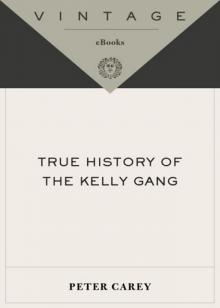 True History of the Kelly Gang
True History of the Kelly Gang 30 Days in Sydney: A Wildly Distorted Account
30 Days in Sydney: A Wildly Distorted Account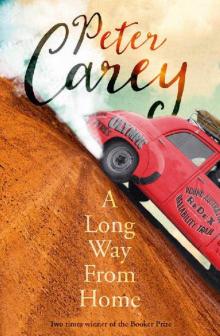 A Long Way From Home
A Long Way From Home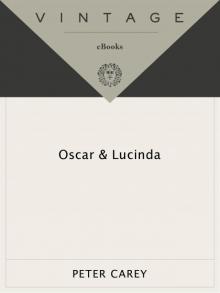 Oscar and Lucinda
Oscar and Lucinda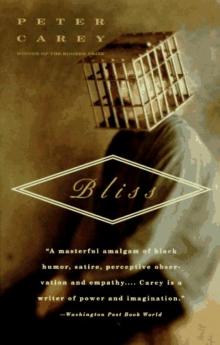 Bliss
Bliss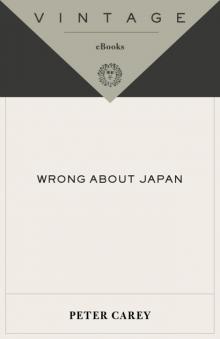 Wrong About Japan
Wrong About Japan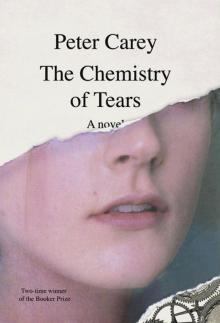 The Chemistry of Tears
The Chemistry of Tears The Tax Inspector
The Tax Inspector Theft: A Love Story
Theft: A Love Story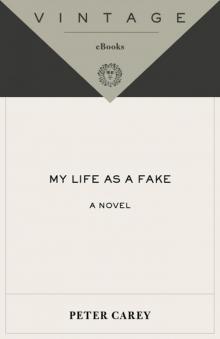 My Life as a Fake
My Life as a Fake Collected Stories
Collected Stories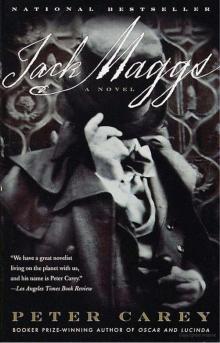 Jack Maggs
Jack Maggs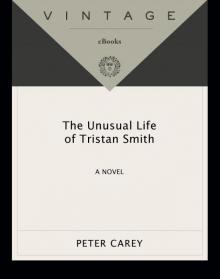 The Unusual Life of Tristan Smith
The Unusual Life of Tristan Smith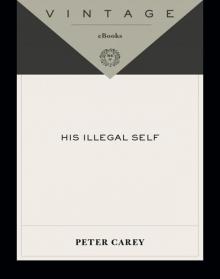 His Illegal Self His Illegal Self His Illegal Self
His Illegal Self His Illegal Self His Illegal Self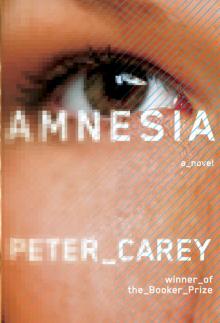 Amnesia: A Novel
Amnesia: A Novel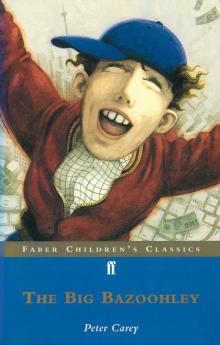 The Big Bazoohley
The Big Bazoohley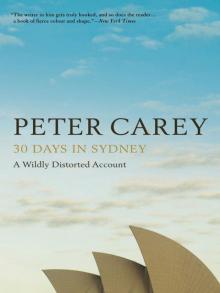 30 Days in Sydney
30 Days in Sydney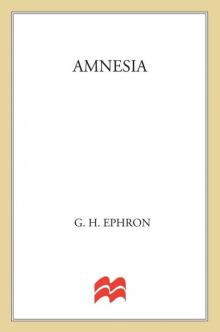 Amnesia
Amnesia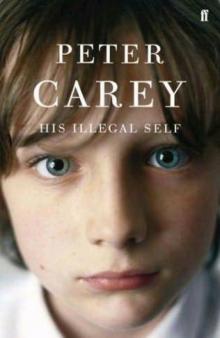 His Illegal Self
His Illegal Self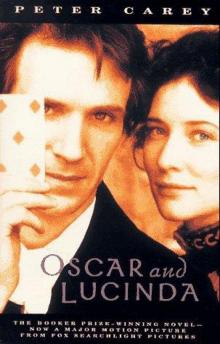 Oscar and Lucinda bw-1988
Oscar and Lucinda bw-1988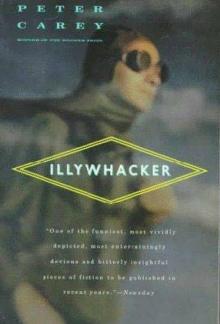 Illywhacker
Illywhacker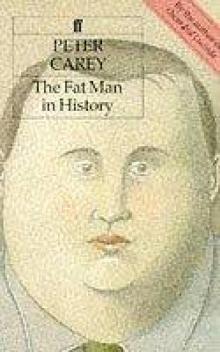 The Fat Man in History aka Exotic Pleasures
The Fat Man in History aka Exotic Pleasures